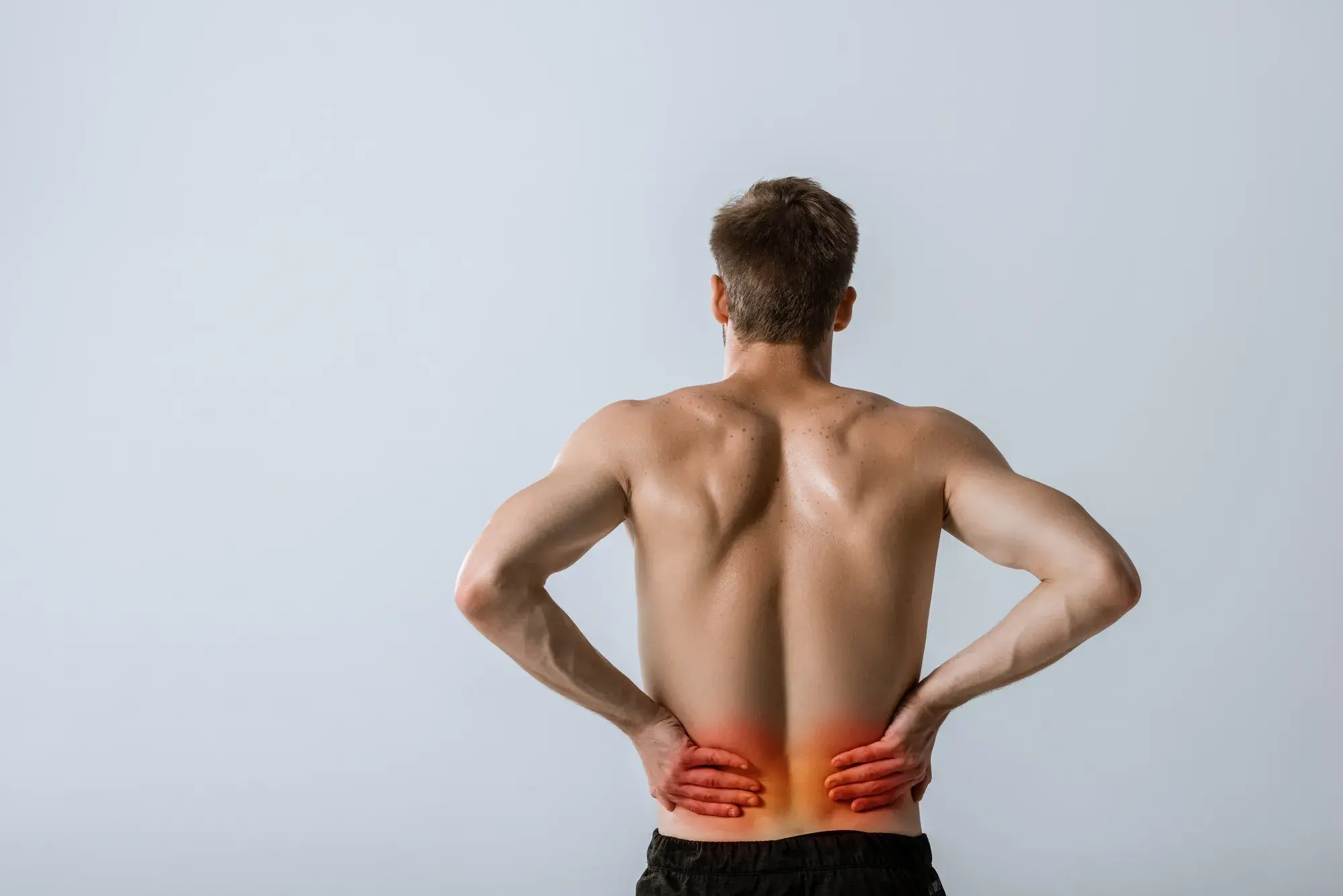Back Pain

How To Tell If Back Pain Is Muscle Or Disc
Read More
April 25, 2023
Lower back pain can be a real issue in many people’s lives. It can be caused by an injury, poor posture, and even just normal aging. Fortunately, there are many treatment solutions available. However, not all of those solutions are ideal. For example, we always recommend against surgery or pain medications, both of which are risky and can have long-term adverse effects.
At Relatyv, we take a whole-person approach, which includes the implementation of lifestyle counseling as part of our treatment protocol. As far as back pain goes, we may recommend different types of exercises tailored to the individual patient. With the proper exercise program, you can reduce chronic lower back pain and mitigate future pain and other issues.
Lower back pain is a very common issue people face. It is estimated that up to 80% of people may experience discomfort or pain in their lower back at some point in their lives. The reason lower back pain is so prevalent is that there are so many different issues that can contribute to it. Some of the common causes of lower back pain include:
Poor posture can be caused by sitting in the same position for too long, or it can simply result from poor habits, such as slouching when sitting or sleeping in an awkward position. Poor posture can cause the lower back muscles to become tense and strained, leading to pain and discomfort.
Muscle strain is caused by sudden or repetitive movements that put too much stress on the lower back muscles. This can range from heavy lifting to being active for extended periods of time. Ligament strain, however, usually occurs when a joint moves beyond its normal range of motion, such as twisting suddenly or stretching too far. Such injuries often result from playing sports or participating in other recreational activities.
Nerve damage can be caused by various factors, including trauma, herniated discs, and spinal stenosis. These issues can occur due to a single event (such as an accident) or result from long-term wear and tear. Nerve damage is usually characterized by a shooting or burning pain in the lower back that can radiate down the legs.
Nerve damage may also cause numbness and tingling in the affected area. If left untreated, nerve damage can also cause muscle weakness and even paralysis.
Spinal degeneration occurs over the course of years, resulting from normal wear and tear on the spine. As people age, the discs in their spine become less flexible, and the joints begin to stiffen. This could lead to pain and discomfort in the lower back. Trauma, such as a car accident, can also lead to a spinal injury that can cause lower back pain.
Specific exercises can be incredibly effective at helping to reduce your lower back pain. The following are some examples of how exercise can benefit your lower back issues:
Certain exercises can help to improve your mobility by stretching and strengthening the muscles of your lower back. This helps to reduce tension in the area and can improve your range of motion and flexibility. As a result, you may experience less pain and discomfort when moving around. Also, increased flexibility can help prevent you from aggravating your lower back pain with sudden movements.
Exercise can help to reduce the pain in your lower back by strengthening the muscles and ligaments of the affected area. This helps to support the spine, relieve tension, and mitigate further injury. Additionally, increased blood flow can help to reduce inflammation in the affected area, which can reduce pain.
Exercises specifically designed to target the muscles of the lower back can help enhance their strength and stability. This can provide long-term relief from pain and discomfort by decreasing the strain placed on your lower back. Additionally, improving your strength can help you to move more freely, reducing the likelihood of further injury.
Although certain exercises can be incredibly beneficial for your lower back, they can be detrimental if you’re not doing them properly — or if the exercises you’re doing are too strenuous. To ensure that you’re protecting your lower back, here are a few precautions to keep in mind before engaging in any form of exercise:
When it comes to lower back pain, there are several different exercises that can help to improve flexibility, range of motion, and strength, thereby helping to reduce pain and discomfort. The following are the different types of lower back pain exercises that we may recommend as part of our lifestyle counseling services:
Stretching can relieve pain and tension in the lower back by increasing flexibility and range of motion. Additionally, stretching helps to reduce stiffness and tension in the lower back muscles, allowing for more comfortable movement. To ensure that your stretching is effective and safe, focusing on proper form and targeting the right muscles is critical. One thing to keep in mind is to avoid twisting and extending simultaneously.
The following are some of the stretching exercises that tend to be appropriate for patients with lower back pain:
Strengthening the core muscles is essential for managing lower back pain. The core muscles help provide stability and support for the spine, which helps reduce pain and discomfort by improving posture and mobility. Additionally, if you have a strong core, you’ll be better able to manage and reduce the strain on your lower back. The following are a few core strengthening exercises that can help you manage lower back pain:
Low-impact aerobic exercises can be an effective way to manage lower back pain. These exercises are gentle on your joints, reduce the strain on your lower back, and help improve your overall cardiovascular fitness. They can also help you lose weight, which may relieve some of the pressure off your back. Some examples of low-impact aerobic exercises include the following:
While some exercises can help manage lower back pain, certain activities may aggravate it. Any exercise that puts too much strain on your lower back should be avoided. These include activities such as the following:
Toe touches can be hard on your lower back as they require you to bend over and reach for your toes. This can put too much strain on your lower back, so it should be avoided if you’re experiencing pain.
Lifting heavy weights of any kind can put too much strain on your lower back, so it should be avoided if you’re experiencing pain. If you want to do strength training, focus on low-weight exercises that don’t require you to lift more than your own body weight.
Situps and abdominal crunches can be hard on your lower back as they require you to lift your torso off the floor. Doing so may put too much strain on your lower back because of the resulting torque. If you’re trying to improve your core strength, focus on exercises like planks and glute bridges instead.
Leg lifts and double leg raises can be dangerous for people with lower back pain, as they require you to lift both legs off the ground. This puts a great deal of strain on your lower back and should be avoided if you’re experiencing pain.
If you have mild to moderate lower back pain, many of these exercises — along with simple rest — can help reduce your discomfort. However, if your pain is more severe or does not improve with rest and exercise, it is vital to seek medical help. At this point, you’ll want a proper diagnosis of what’s causing your lower back so that your treatment (including exercises) can be tailored to your specific condition.
Exercise can be an effective way to manage lower back pain. However, it’s essential to focus on exercises that don’t put too much strain on your lower back and avoid those which can exacerbate the pain. At Relatyv, we provide lifestyle advice as part of our whole-person approach to pain management. Depending on your diagnosis, we may recommend various exercises in conjunction with our drug-free, non-chiropractic, non-invasive forms of treatment to help you regain your movement without experiencing lower back pain.
About the Author
Will is a healthcare executive, innovator, entrepreneur, inventor, and writer with a wide range of experience in the medical field. Will has multiple degrees in a wide range of subjects that give depth to his capability as an entrepreneur and capacity to operate as an innovative healthcare executive.
Share on Social Media




You can see how this popup was set up in our step-by-step guide: https://wppopupmaker.com/guides/auto-opening-announcement-popups/
You can see how this popup was set up in our step-by-step guide: https://wppopupmaker.com/guides/auto-opening-announcement-popups/
Neurofunctional Pain Management Overview
Symptoms
Conditions Treated
Treatments
Articles by Category
Locations
Colorado
Wisconsin
Georgia
Hiram
Lawrenceville
Marietta
Powder Springs
Texas
Waco
Victoria
Illinois
Buffalo Grove
New Lenox
St. Charles
Arizona
Tucson
Waddell
Arlington
Avondale
Buckeye
Superior
Mesa
Palo Verde
Morristown
Tempe
Chandler
Anthem
Eloy
Florence
Fort McDowell
Phoenix
El Mirage
Coolidge
Gilbert
Arizona City
Casa Grande
Casa Blanca
Aguila
Sacaton
Apache Junction
Kearny
Stanfield
Goodyear
Litchfield Park
Alabama
Arkansas
California
Florida
Idaho
Indiana
Iowa
Kansas
Louisiana
Maryland
Michigan
Rhode Island
Minnesota
Mississippi
Nevada
New Jersey
New Mexico
North Carolina
Ohio
Pennsylvania
South Dakota
Tennessee
Utah
Virginia
Washington

